watertreatment
自来水处理去除高锰酸盐指数的方法

自来水处理去除高锰酸盐指数的方法英文回答:Water treatment is essential to remove contaminants and ensure the safety of drinking water. One of the contaminants that needs to be addressed is the permanganate index, also known as the permanganate value or the permanganate number. The permanganate index measures the amount of oxidizable organic and inorganic substances in water.There are several methods available to remove permanganate from water. One common method is chemical oxidation using potassium permanganate. This method involves adding potassium permanganate to the water, which reacts with the organic and inorganic substances, converting them into insoluble manganese dioxide. The manganese dioxide can then be removed through filtration or settling.Another method to remove permanganate is through biological treatment. This method utilizes microorganismsto break down the organic and inorganic substances. The microorganisms feed on the contaminants, converting theminto harmless byproducts. This method is often used in conjunction with other water treatment processes, such as activated carbon filtration or ion exchange.In addition to chemical oxidation and biological treatment, there are also physical methods available to remove permanganate. One such method is air stripping,which involves passing air through the water to strip out the contaminants. This method is effective for volatile organic compounds, but may not be as effective forinorganic substances.Another physical method is adsorption, where activated carbon or other adsorbent materials are used to adsorb the contaminants. The adsorbent material has a large surface area, allowing it to attract and trap the permanganate ions. This method is commonly used in water treatment plants and can be combined with other processes for optimal removal.In summary, there are multiple methods available to remove permanganate from water, including chemical oxidation, biological treatment, air stripping, and adsorption. Each method has its own advantages and limitations, and the choice of method depends on the specific water quality and treatment goals.中文回答:水处理是去除污染物、确保饮用水安全的必要过程。
water treatment的英语作文
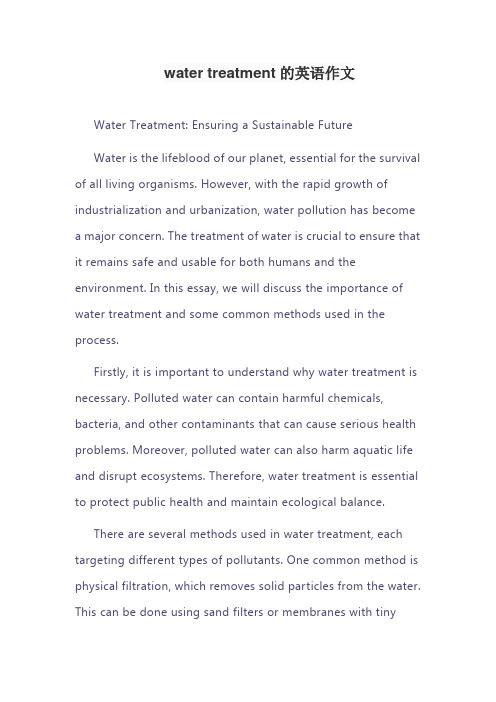
water treatment的英语作文Water Treatment: Ensuring a Sustainable FutureWater is the lifeblood of our planet, essential for the survival of all living organisms. However, with the rapid growth of industrialization and urbanization, water pollution has become a major concern. The treatment of water is crucial to ensure that it remains safe and usable for both humans and the environment. In this essay, we will discuss the importance of water treatment and some common methods used in the process.Firstly, it is important to understand why water treatment is necessary. Polluted water can contain harmful chemicals, bacteria, and other contaminants that can cause serious health problems. Moreover, polluted water can also harm aquatic life and disrupt ecosystems. Therefore, water treatment is essential to protect public health and maintain ecological balance.There are several methods used in water treatment, each targeting different types of pollutants. One common method is physical filtration, which removes solid particles from the water. This can be done using sand filters or membranes with tinypores that only allow water molecules to pass through. Another method is chemical treatment, which involves adding chemicals to the water to neutralize or precipitate contaminants. For example, chlorine is often added to drinking water to kill bacteria and viruses.Biological treatment is another effective method used in water treatment. This involves using microorganisms to break down organic matter in the water. The most common type of biological treatment is activated sludge, where microorganisms are mixed with oxygen-rich air to form a floc that settles at the bottom of the tank. The clean water is then separated from the floc and discharged into the environment.In addition to these conventional methods, there are also advanced technologies such as reverse osmosis and ultraviolet disinfection. Reverse osmosis involves pushing water through a semipermeable membrane that allows only water molecules to pass through, leaving behind salts and other impurities. Ultraviolet disinfection uses UV light to damage the DNA of microorganisms, rendering them unable to reproduce and eventually leading to their death.Despite the effectiveness of these methods, there are still challenges in implementing them on a large scale. One major challenge is the cost associated with building and maintaining treatment facilities. Another challenge is ensuring that treated water meets stringent safety standards before being released into the environment or supplied to consumers.In conclusion, water treatment is a critical process that plays a vital role in protecting public health and preserving the environment. By employing various methods such as physical filtration, chemical treatment, biological treatment, reverse osmosis, and ultraviolet disinfection, we can effectively remove pollutants from water and make it safe for use. However, more efforts are needed to overcome challenges related to cost and safety standards to ensure a sustainable future for our planet's most precious resource – water.。
water treatment英语作文

Water Treatment: A Crucial Step towardsSustainable DevelopmentWater, the essence of life, plays a pivotal role in maintaining the well-being of all living beings. However, with the ever-increasing anthropogenic activities, water bodies are getting contaminated, posing a serious threat to the availability of clean and potable water. Water treatment, therefore, emerges as a crucial step towards ensuring the sustainability of water resources and promoting healthy ecosystems.The process of water treatment involves various physical, chemical, and biological methods to remove contaminants from water, making it suitable for human consumption and other purposes. The treatment process typically begins with the removal of solid particles and suspended matter through sedimentation and filtration. This is followed by the addition of chemicals to neutralize acids or bases, coagulation of colloids, and precipitation of dissolved solids. Chlorination or ozonation is then employed to kill pathogenic microorganisms, ensuring microbiological safety.Advanced water treatment techniques, such as activated sludge process, membrane filtration, and reverse osmosis, are also utilized to further purify water, removing trace contaminants and improving its quality. These techniques are particularly useful in treating water from polluted sources or in areas where water scarcity is a pressing issue.The importance of water treatment cannot be overstated. Untreated water, containing harmful bacteria, viruses, parasites, and chlorine-resistant organisms, can lead to various water-borne diseases, including diarrhea, cholera, and typhoid. Children, pregnant women, and individuals with compromised immune systems are particularly vulnerable to these diseases. Therefore, investing in effective water treatment facilities is crucial for ensuring the health and well-being of communities.Moreover, water treatment plays a vital role in sustainable development. As demand for water continues to grow, so does the need for sustainable water management practices. Water treatment not only ensures theavailability of clean and potable water but also promoteswater conservation and recycling. By reducing water waste and enhancing water use efficiency, water treatment contributes to achieving sustainable development goals, such as ensuring access to affordable and clean water for all.In conclusion, water treatment is a fundamental aspect of water management, essential for safeguarding human health, protecting ecosystems, and promoting sustainable development. By investing in innovative water treatment technologies and implementing sustainable water management practices, we can ensure the availability of clean and potable water for future generations.**水处理:通往可持续发展的关键一步**水,生命的本质,在维持所有生物的福祉方面起着至关重要的作用。
水处理英语介绍作文
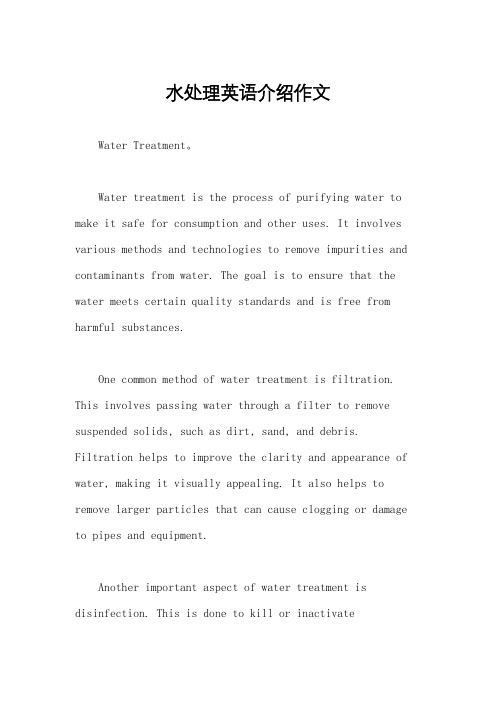
水处理英语介绍作文Water Treatment。
Water treatment is the process of purifying water to make it safe for consumption and other uses. It involves various methods and technologies to remove impurities and contaminants from water. The goal is to ensure that the water meets certain quality standards and is free from harmful substances.One common method of water treatment is filtration. This involves passing water through a filter to remove suspended solids, such as dirt, sand, and debris. Filtration helps to improve the clarity and appearance of water, making it visually appealing. It also helps to remove larger particles that can cause clogging or damage to pipes and equipment.Another important aspect of water treatment is disinfection. This is done to kill or inactivatemicroorganisms, such as bacteria, viruses, and parasites, that may be present in water. Disinfection can be achieved through various methods, including the use of chemical disinfectants like chlorine or ultraviolet (UV) radiation. It is essential to disinfect water to prevent waterborne diseases and ensure public health.In addition to filtration and disinfection, water treatment may also involve the use of chemical coagulants and flocculants. These chemicals help to remove fine particles and colloidal matter from water by causing them to clump together and settle. Coagulation and flocculation are important steps in water treatment as they improve the efficiency of filtration and remove substances that can affect water quality and taste.Water treatment is not only important for drinking water, but also for various industrial processes. Many industries rely on water for their operations, and it is crucial to treat the water to meet the specific requirements of each industry. For example, in the manufacturing industry, water treatment is necessary toremove impurities that can affect the quality of products or damage equipment.Overall, water treatment plays a vital role in ensuring the availability of clean and safe water for various purposes. It helps to protect public health, preserve the environment, and support sustainable development. With the increasing demand for water and the growing concerns about water pollution, effective water treatment becomes more important than ever. By implementing proper water treatment processes and technologies, we can ensure that everyone has access to clean and safe water.。
water treatment
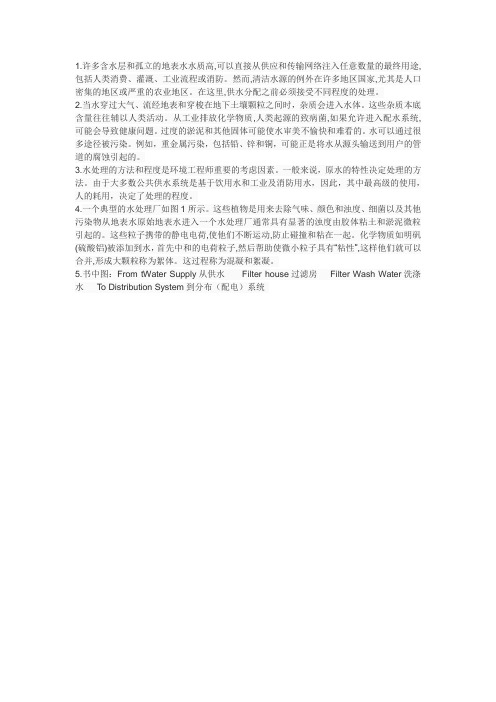
1.许多含水层和孤立的地表水水质高,可以直接从供应和传输网络注入任意数量的最终用途,包括人类消费、灌溉、工业流程或消防。
然而,清洁水源的例外在许多地区国家,尤其是人口密集的地区或严重的农业地区。
在这里,供水分配之前必须接受不同程度的处理。
2.当水穿过大气、流经地表和穿梭在地下土壤颗粒之间时,杂质会进入水体。
这些杂质本底含量往往辅以人类活动。
从工业排放化学物质,人类起源的致病菌,如果允许进入配水系统,可能会导致健康问题。
过度的淤泥和其他固体可能使水审美不愉快和难看的。
水可以通过很多途径被污染。
例如,重金属污染,包括铅、锌和铜,可能正是将水从源头输送到用户的管道的腐蚀引起的。
3.水处理的方法和程度是环境工程师重要的考虑因素。
一般来说,原水的特性决定处理的方法。
由于大多数公共供水系统是基于饮用水和工业及消防用水,因此,其中最高级的使用,人的耗用,决定了处理的程度。
4.一个典型的水处理厂如图1所示。
这些植物是用来去除气味、颜色和浊度、细菌以及其他污染物从地表水原始地表水进入一个水处理厂通常具有显著的浊度由胶体粘土和淤泥微粒引起的。
这些粒子携带的静电电荷,使他们不断运动,防止碰撞和粘在一起。
化学物质如明矾(硫酸铝)被添加到水,首先中和的电荷粒子,然后帮助使微小粒子具有“粘性”,这样他们就可以合并,形成大颗粒称为絮体。
这过程称为混凝和絮凝。
5.书中图:From tWater Supply从供水Filter house过滤房Filter Wash Water洗涤水To Distribution System到分布(配电)系统。
WATER TREATMENT
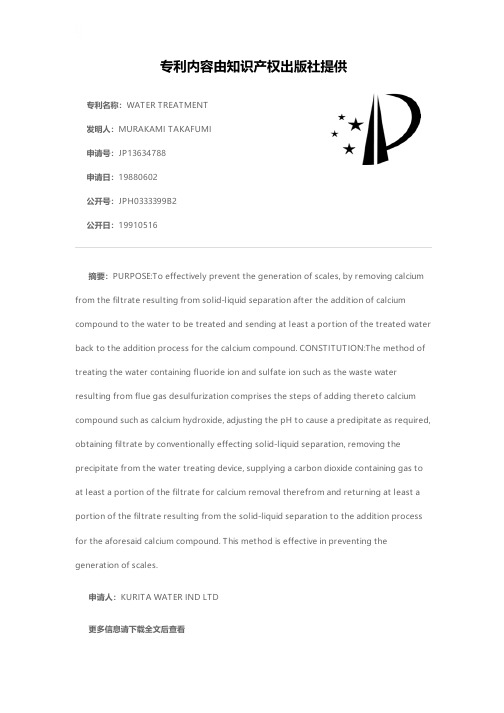
专利名称:WATER TREATMENT 发明人:MURAKAMI TAKAFUMI 申请号:JP13634788申请日:19880602公开号:JPH0333399B2公开日:19910516专利内容由知识产权出版社提供摘要:PURPOSE:To effectively prevent the generation of scales, by removing calcium from the filtrate resulting from solid-liquid separation after the addition of calcium compound to the water to be treated and sending at least a portion of the treated water back to the addition process for the calcium compound. CONSTITUTION:The method of treating the water containing fluoride ion and sulfate ion such as the waste water resulting from flue gas desulfurization comprises the steps of adding thereto calcium compound such as calcium hydroxide, adjusting the pH to cause a predipitate as required, obtaining filtrate by conventionally effecting solid-liquid separation, removing the precipitate from the water treating device, supplying a carbon dioxide containing gas to at least a portion of the filtrate for calcium removal therefrom and returning at least a portion of the filtrate resulting from the solid-liquid separation to the addition process for the aforesaid calcium compound. This method is effective in preventing the generation of scales.申请人:KURITA WATER IND LTD更多信息请下载全文后查看。
WATER TREATMENT
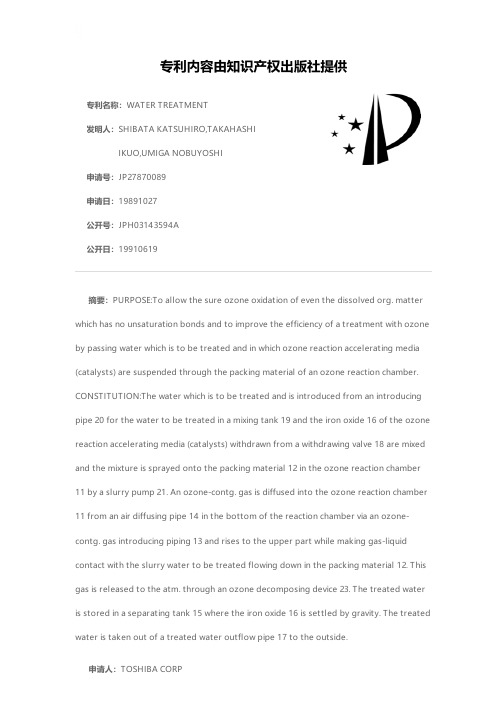
专利名称:WATER TREATMENT发明人:SHIBATA KATSUHIRO,TAKAHASHI IKUO,UMIGA NOBUYOSHI申请号:JP27870089申请日:19891027公开号:JPH03143594A公开日:19910619专利内容由知识产权出版社提供摘要:PURPOSE:To allow the sure ozone oxidation of even the dissolved org. matter which has no unsaturation bonds and to improve the efficiency of a treatment with ozone by passing water which is to be treated and in which ozone reaction accelerating media (catalysts) are suspended through the packing material of an ozone reaction chamber. CONSTITUTION:The water which is to be treated and is introduced from an introducing pipe 20 for the water to be treated in a mixing tank 19 and the iron oxide 16 of the ozone reaction accelerating media (catalysts) withdrawn from a withdrawing valve 18 are mixed and the mixture is sprayed onto the packing material 12 in the ozone reaction chamber 11 by a slurry pump 21. An ozone-contg. gas is diffused into the ozone reaction chamber 11 from an air diffusing pipe 14 in the bottom of the reaction chamber via an ozone-contg. gas introducing piping 13 and rises to the upper part while making gas-liquid contact with the slurry water to be treated flowing down in the packing material 12. This gas is released to the atm. through an ozone decomposing device 23. The treated water is stored in a separating tank 15 where the iron oxide 16 is settled by gravity. The treated water is taken out of a treated water outflow pipe 17 to the outside.申请人:TOSHIBA CORP更多信息请下载全文后查看。
WATER TREATMENT
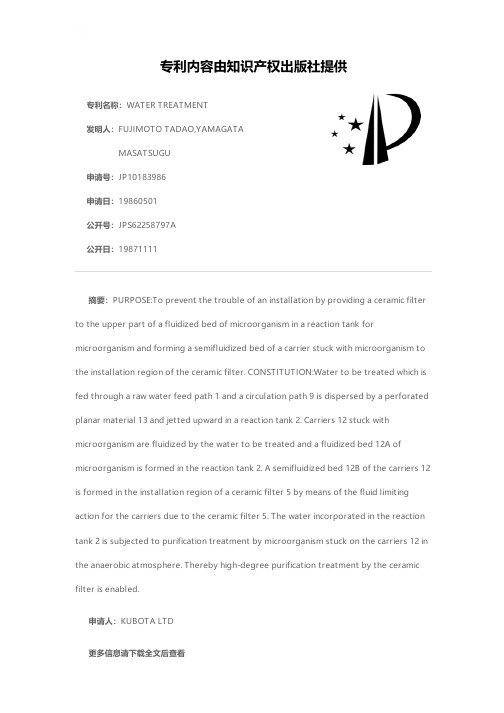
专利名称:WATER TREATMENT发明人:FUJIMOTO TADAO,YAMAGATA MASATSUGU申请号:JP10183986申请日:19860501公开号:JPS62258797A公开日:19871111专利内容由知识产权出版社提供摘要:PURPOSE:To prevent the trouble of an installation by providing a ceramic filter to the upper part of a fluidized bed of microorganism in a reaction tank for microorganism and forming a semifluidized bed of a carrier stuck with microorganism to the installation region of the ceramic filter. CONSTITUTION:Water to be treated which is fed through a raw water feed path 1 and a circulation path 9 is dispersed by a perforated planar material 13 and jetted upward in a reaction tank 2. Carriers 12 stuck with microorganism are fluidized by the water to be treated and a fluidized bed 12A of microorganism is formed in the reaction tank 2. A semifluidized bed 12B of the carriers 12 is formed in the installation region of a ceramic filter 5 by means of the fluid limiting action for the carriers due to the ceramic filter 5. The water incorporated in the reaction tank 2 is subjected to purification treatment by microorganism stuck on the carriers 12 in the anaerobic atmosphere. Thereby high-degree purification treatment by the ceramic filter is enabled.申请人:KUBOTA LTD更多信息请下载全文后查看。
WATER TREATMENT
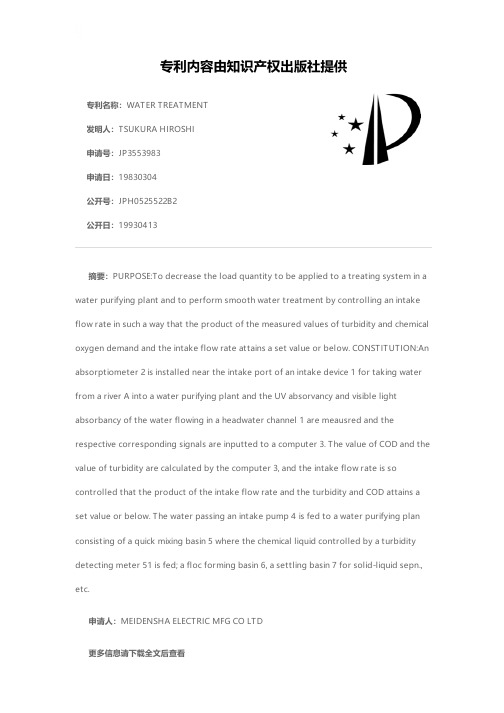
专利名称:WATER TREATMENT 发明人:TSUKURA HIROSHI申请号:JP3553983申请日:19830304公开号:JPH0525522B2公开日:19930413专利内容由知识产权出版社提供摘要:PURPOSE:To decrease the load quantity to be applied to a treating system in a water purifying plant and to perform smooth water treatment by controlling an intake flow rate in such a way that the product of the measured values of turbidity and chemical oxygen demand and the intake flow rate attains a set value or below. CONSTITUTION:An absorptiometer 2 is installed near the intake port of an intake device 1 for taking water from a river A into a water purifying plant and the UV absorvancy and visible light absorbancy of the water flowing in a headwater channel 1 are meausred and the respective corresponding signals are inputted to a computer 3. The value of COD and the value of turbidity are calculated by the computer 3, and the intake flow rate is so controlled that the product of the intake flow rate and the turbidity and COD attains a set value or below. The water passing an intake pump 4 is fed to a water purifying plan consisting of a quick mixing basin 5 where the chemical liquid controlled by a turbidity detecting meter 51 is fed; a floc forming basin 6, a settling basin 7 for solid-liquid sepn., etc.申请人:MEIDENSHA ELECTRIC MFG CO LTD更多信息请下载全文后查看。
water treatment

Clarification - Three step process:
• Coagulation, accomplished by rapid mixing of chemical coagulant with “raw” (untreated) water, followed by • Slow mixing or flocculation, in which floc attracts colloidal solids, and • Sedimentation, in which gravity settles solids out of solution.
Flocculation:
• Flocculation is process to promote aggregation and sedimentation of particles. • Success of the flocculation is dependent first on
– The effectiveness of the coagulation in the raw water – The flocculation process must provide adequate time for the desired floc size and density to form
Vertical flocculator
1. 2. 3. 4. 5. 6. 7. 8. 9. Driver Motor Variable Speed Device Gear Reducer Drive shaft coupling Thrust Collar Radical Thrust Bearing Drive Base Paddle Reel Assemblies Bottom Steady Bearing
净水工艺基础知识讲解
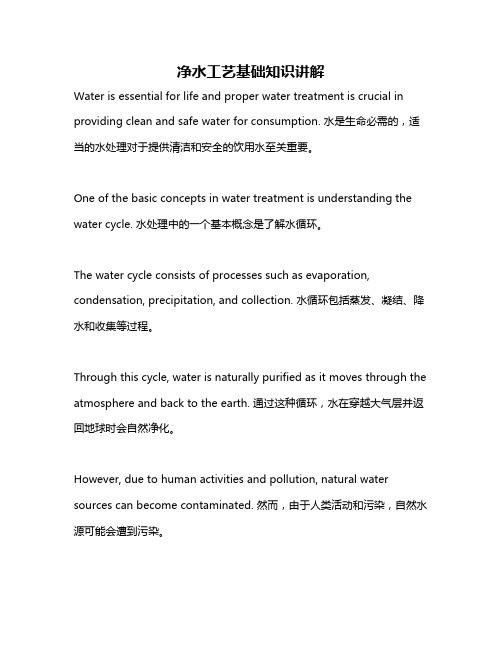
净水工艺基础知识讲解Water is essential for life and proper water treatment is crucial in providing clean and safe water for consumption. 水是生命必需的,适当的水处理对于提供清洁和安全的饮用水至关重要。
One of the basic concepts in water treatment is understanding the water cycle. 水处理中的一个基本概念是了解水循环。
The water cycle consists of processes such as evaporation, condensation, precipitation, and collection. 水循环包括蒸发、凝结、降水和收集等过程。
Through this cycle, water is naturally purified as it moves through the atmosphere and back to the earth. 通过这种循环,水在穿越大气层并返回地球时会自然净化。
However, due to human activities and pollution, natural water sources can become contaminated. 然而,由于人类活动和污染,自然水源可能会遭到污染。
That's where water treatment processes come in to ensure that water is safe and clean for consumption. 正是水处理工艺的出现确保了水源的安全和洁净。
Water treatment processes involve several steps, starting from intake and screening to disinfection and distribution. 水处理过程涉及几个步骤,从进水和筛查到消毒和分配。
【实用文档】Water treatments
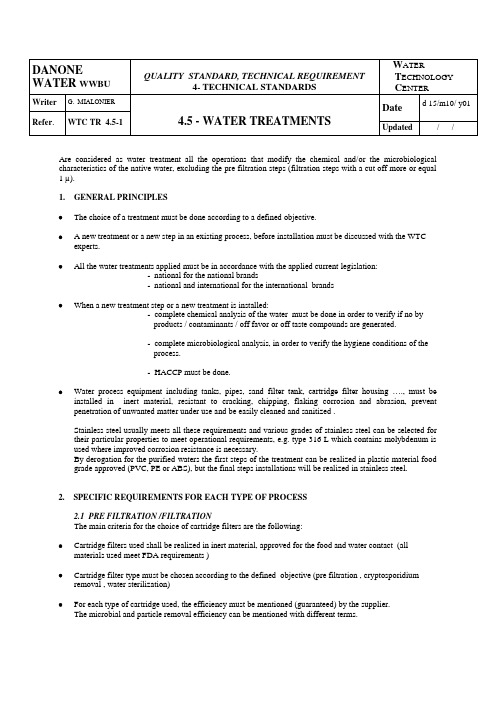
Are considered as water treatment all the operations that modify the chemical and/or the microbiological characteristics of the native water, excluding the pre filtration steps (filtration steps with a cut off more or equal 1 µ).1.GENERAL PRINCIPLES•The choice of a treatment must be done according to a defined objective.• A new treatment or a new step in an existing process, before installation must be discussed with the WTC experts.•All the water treatments applied must be in accordance with the applied current legislation:- national for the national brands- national and international for the international brands•When a new treatment step or a new treatment is installed:- complete chemical analysis of the water must be done in order to verify if no byproducts / contaminants / off favor or off taste compounds are generated.- complete microbiological analysis, in order to verify the hygiene conditions of theprocess.- HACCP must be done.•Water process equipment including tanks, pipes, sand f ilter tank, cartridge filter housing …., must be installed in inert material, resistant to cracking, chipping, flaking corrosion and abrasion, prevent penetration of unwanted matter under use and be easily cleaned and sanitized .Stainless steel usually meets all these requirements and various grades of stainless steel can be selected for their particular properties to meet operational requirements, e.g. type 316 L which contains molybdenum is used where improved corrosion resistance is necessary.By derogation for the purified waters the first steps of the treatment can be realized in plastic material food grade approved (PVC, PE or ABS), but the final steps installations will be realized in stainless steel.2.SPECIFIC REQUIREMENTS FOR EACH TYPE OF PROCESS2.1 PRE FILTRATION /FILTRATIONThe main criteria for the choice of cartridge filters are the following:•Cartridge filters used shall be realized in inert material, approved for the food and water contact (all materials used meet FDA requirements )•Cartridge filter type must be chosen according to the defined objective (pre filtration , cryptosporidium removal , water sterilization)•For each type of cartridge used, the efficiency must be mentioned (guaranteed) by the supplier.The microbial and particle removal efficiency can be mentioned with different terms.- Typical removal efficiency with an identified challenge contaminantEx : Pseudomonas diminutaNr organisms incident on filterIn this case the TR efficiency =Nr organisms detected in effluentThis removal efficiency can be defined like Log reduction value-Typical removal efficiency, using aqueous suspension of AC fine test dustIn this case the efficiency is defined like theNr particles >given size in influentβ=Nr particles > given size in effluentβ 5000 corresponds to a 99,98 % removal efficiency•For the last pre filtration step in a water process or for a filtration in order to decrease a specific type of germ or parasite the minimal efficiency shall be 99,98 %.•At the minimum for all bottled waters a final filtration step in order to eliminate cryptosporidium risk will be installed (at least 1µ, efficiency ≥ 99,98%).•Cleaning and sanitizing procedures (including sanitizing agents, concentrations, steam and hot water sterilization possibilities).•Cartridge filter size and flow rate correlated with the differential pressure.•Maximum differential pressure or pressure drop.•Adapter typeWhen a membrane (microbiological cartridge) is installed in order to remove or to minimize a microbiological risk it’s necessary to protect this final filtration step by a pre filter in order to increase the membrane‘s life. The choice of the filtration step sequence will be established after water characterizat ion and specially fouling index analysis.In order to verify the efficiency of the cartridge filters (final filtration), it’s necessary to check especially after cleaning or sanitizing operations the filter’s performance by an integrity test.2.2 ARSENIC / IRON /MANGANESE REMOVAL TREATMENTIn order to decrease the level of iron , Manganese in a water two types of technologies can be used: •oxidation by air, oxygen or ozone and filtration•removal on manganese dioxide filter without previous oxidationThis second technology is also used for the arsenic and radio element removal.SPECIFIC REQUIREMENTS REGARDING AN OXIDATION PROCESS•Water pH just before oxidation must be > to 7 ( in the case of sparkling water ,the Carbon dioxide is removed before oxidation step by a vacuum pump)•Air used for the oxidation step shall be filtered before use in order to prevent the microbiological risk SPECIFIC REQUIREMENTS REGARDING MANGANESE DIOXIDE TECHNOLOGY•Specification of the manganese dioxide that you must use is the followingSPECIFICATIONSMnO2 MF12, granulated and screened washed and driedSize: 0.355-0.710 mm, less than 5 % coarser than 0.710 and less than 5 % finer than 0.355Specific surface at least: 14 m2/gHumidity: less than 5% waterReferenceAddress CVRD (producer) in Brazil:COMPANHIA VALE DO RIO DOCESerra dos CARAJASs/n︒ 68516-000 PARAUAPEBAS PA BRAZILPhone number : 00 55 91 327 11 80 fax : 00 55 91 327 11 49Address CAS (distributor)Eastfield Road, South Killingholme, GRIMSBYSouth Humberside DN 40 3NF, UKPhone number: 00 44 1469 57 47 15, 00 44 113 282 1405,2.3 UV TREATMENTThe UV systems shall be installed in accordance with the following requirements :•What’s the objective?-disinfection-destruction of ozone-removal of total chlorine-TOC reductionThe lamp characteristics depend of the real objective, for TOC reduction the 185nm wavelength is used because more powerful than 254nm (wavelength used for disinfection).•UV power installed (µw.s/cm2) shall be known for each equipment (average and minimum UV power at the end of the lamp life).•UV lamp life must be known (average 8000 hours) and the real UV power monitored.•UV power shall be chosen according the range of flow rate used and in order to obtain a defined log reduction value for bacteria and or viruses.In order to obtain about 5/6 log reduction against the enteric viruses, the UV power recommended is60 000 µw.s/cm2The minimum UV power in a multi step water treatment is 30 000µws/cm2.•UV sensor shall be installed in order to follow the UV power•If the UV equipment is installed after the last filtration step ( just before filler ) a strainer shall be installed in order to avoid the glass particle risk in the case of UV lamp breaking.2.4 OZONATIONThe ozonation process can be used for:-disinfection-TOC reduction*-oxidation of mineral elements*bu t use of ozone for TOC reduction isn’t recommended, due to the production of by products.Whatever the objective may be, the main principles are always the same, the key parameters are the quantity of O3 dissolved in the water and the contact time.The quantity of ozone dissolved depends of the following parameters:-injection system-design of the installation (in order to obtain a good mixing)- a good monitoring of the ozone generator by in line sensors (flow meter / in lineozone dosing system).The contact time is a key point in the oxidation process or in the disinfection process without residual ozone at the bottling step. In order to be sure that the contact time is constant it’s necessary to monitor the ozone injection and the water level in the contact tank.Whatever the objective may be, the maximum level of ozone is 0,4mg/lFor s.o.’s information the two principles recommended for the ozone injection are the followingWATER WWBU QUALITY STANDARD, TECHNICAL REQUIREMENT4- TECHNICAL STANDARDS T ECHNOLOGY C ENTERWriter G. MIALONIER4.5 - WATER TREATMENTS Date d 15/m10/ y01Refer. WTC TR 4.5-5Updated / /WATER WWBU QUALITY STANDARD, TECHNICAL REQUIREMENT4- TECHNICAL STANDARDS T ECHNOLOGY C ENTERWriter G. MIALONIER4.5 - WATER TREATMENTS Date d 15/m10/ y01Refer. WTC TR 4.5-6Updated / /2.5 DEMINERALIZATION STEPSDemineralization technologies that can be used for the packaged waters are the following:•Reverse osmosis•Ion exchange resins•DistillationREVERSE OSMOSISWith this technology a key point concerns the RO membranes used.There are four classes of polymers used to produce synthetic semi-permeable membranes•polyamide•TFC (thin film composite)•Cellulose acetate•Cellulose triacetateFor choosing the membranes the main criteria are the following:-pH stability-oxidant resistance (chlorine, O3…)-cleaning agent resistance-biological resistance-temperature limitsDon’t forget also that the performance of an RO system depends largely on the type of membrane selected . Ingeneral thin film composite membranes are more effective than cellulose acetate or polyamide membranes fororganic removal, especially of solvents..The membrane material and the complexing (sequestering ) agent, if a sequestering agent is employed shall be approved for food contact and in accordance with the regulation applied.ION EXANGE RESINSDemineralization by ion exchange technology is often employed in combination with other water technologies, such as reverse osmosis or distillation, or for specific element removal.But some problems can appear with the ion exchange technologies (unpleasant taste and odor, migration, high bacteria levels *…) for this reason the ion exchange technologies could be used if no alternative way exists.If the ion exchange resins are used, the resins must be approved for the drinking water treatment by the official authorities.* Resin beads have a large contact surface. They give microorganisms the opportunity to grow. That is the main reason to these problems. Beside the regenerating operations, you’ll als o have to take into account sanitizing steps. Sanitizing process and frequency have to define carefully.DISTILLATIONDistillation can be used to produce purified or distilled water, but don’t forget that distillation process doesn’t remove chlorine or volatile organic chemical compounds.If a sequestering agent is used, it must be approved for the drinking water treatment by the official authorities.2.6 MINERALIZATION STEPSMinerals can be added to water by two type of process:-addition of concentrated solutions of minerals to the base water .-dissolution of calcium /magnesium in the water after contact with limestone. The DANONE requirements regarding these technologies are the following:•all the dry minerals used should meet purity standards set by Food chemical Codex (see chapter 2: NORMS / 2.2 RAW MATERIALS AND SUPPLIES).•the process must be under control (the conductivity, flow rate and concentrated solution consumption should be checked at least each hour ).•fluoride addition will be mad e only by batch process, an in line injection isn’t allowed, but you can also inject in “semi online process” with an intermediate small tank and a final tank (volume equal 1 hour of bottling). The fluoride concentration must be checked on each batch of finished product before bottling.Semi on line fluoride process2.7 CARBON FILTRATIONActivated carbon filters are a mean of removing•chlorine•organic contaminants•off taste and off flavorThere are three types of activated carbon commercially available-granular activated carbon (GAC)-powdered activated carbon (PAC)-compressed carbon blocksGAC is the method of choice for bottled water processing, because it can be used in bed filters. PAC is rarely used and its use is restricted to removal of chlorine or tastes/odors.When a carbon filtration unit is installed, the following principles must be applied:•Define the objective and select the good activated carbon•Don’t use multi layers filter including sand or gravel beds with GAC•Foresee a steam arrival in order to sanitize and to regenerate the carbon bedWhen a carbon filtration is used the following rules must be applied:•carbon filters must be backflushed regularly, in order to prevent a high level of bacteria •microbiological quality of the treated water must be controlled , if the level is high after back flush , a steam sanitizing operation will be made (chlorine sanitization isn’t recommended)•When a filter is used for removal organic contaminants , the efficiency will be controlled (the life of the carbon bed depends of the nature and the type of contaminants). When the efficiency decrease realizes a steam regeneration (if effective) or change the granular activated carbon.•Check permanently the taste and odor of the treated water.Carbon filtration technology can be used exclusively if necessary (to use only if no alternative technology on disposal).2.8 CARBONATING PROCESSRegarding the carbonating process (low or high level) the main rules concern the quality of the CO2 used and the injection process in order to obtain the specified level with a low standard deviation.The CO2 standard quality are mentioned in the WTC data base (FILE N°4 Technical arrangements concerning water ).2.9 FLAVOR , INGREDIENT ADDITIONThe recommendations regarding the ingredients are described in the chapter 2 (raw material and supplies). Regarding the process the ingredients can be added directly to the water only if you used a dedicated bottling line. In the case or a non-dedicated line is used you must added the ingredients by post dosing.3. SPECIFIC PROCEDURE FOR THE IMPLEMENTATION OF A NEW TREATMENTIn the set up of a new treatment or if an existing treatment is largely modified , the different steps under mentioned must be made.•DEFINE THE OBJECTIVE OF THE NEW WATER PROCESSING•DISCUSS THE SOLUTIONS WITH THE WTC EXPERTS•REALIZE IF NECESSARY A PILOT SCALE•DEFINE THE INDUSTRIAL PROCESS AND IN THE SAME TIME ANALYZE THE NEW RISKS (HACCP)(ex : by products generated )•REALIZE THE INDUSTRIAL PROCESS•SET IN PLACE THE SPECIFIC PROCEDURES (control, regenerating conditions, cleaning and sanitizing operations …)•INDUSTRIAL VALIDATION STEP(before to launch the product the process will be tested and the treated water control )0O0。
Water treatment
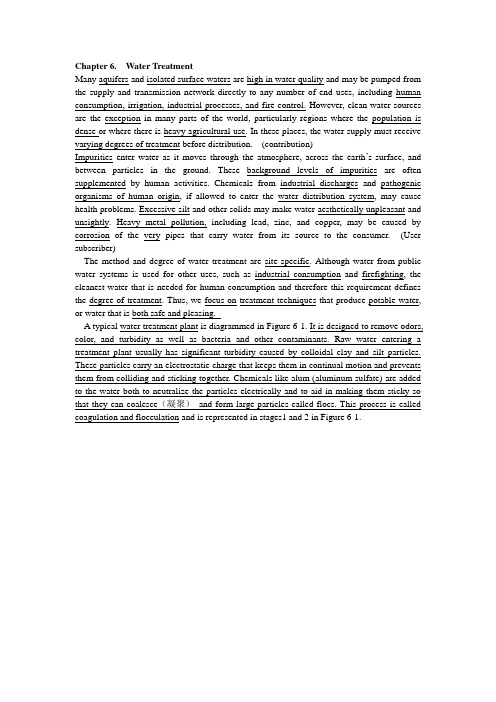
Chapter 6. Water TreatmentMany aquifers and isolated surface waters are high in water quality and may be pumped from the supply and transmission network directly to any number of end uses, including human consumption, irrigation, industrial processes, and fire control. However, clean water sources are the exception in many parts of the world, particularly regions where the population is dense or where there is heavy agricultural use. In these places, the water supply must receive varying degrees of treatment before distribution. (contribution)Impurities enter water as it moves through the atmosphere, across the earth’s surface, and between particles in the ground. These background levels of impurities are often supplemented by human activities. Chemicals from industrial discharges and pathogenic organisms of human origin, if allowed to enter the water distribution system, may cause health problems. Excessive silt and other solids may make water aesthetically unpleasant and unsightly. Heavy metal pollution, including lead, zinc, and copper, may be caused by corrosion of the very pipes that carry water from its source to the consumer. (User subscriber)The method and degree of water treatment are site specific. Although water from public water systems is used for other uses, such as industrial consumption and firefighting, the cleanest water that is needed for human consumption and therefore this requirement defines the degree of treatment. Thus, we focus on treatment techniques that produce potable water, or water that is both safe and pleasing.A typical water treatment plant is diagrammed in Figure 6-1. It is designed to remove odors, color, and turbidity as well as bacteria and other contaminants. Raw water entering a treatment plant usually has significant turbidity caused by colloidal clay and silt particles. These particles carry an electrostatic charge that keeps them in continual motion and prevents them from colliding and sticking together. Chemicals like alum (aluminum sulfate) are added to the water both to neutralize the particles electrically and to aid in making them sticky so that they can coalesce(凝聚)and form large particles called flocs. This process is called coagulation and flocculation and is represented in stages1 and 2 in Figure 6-1.Figure 6-1 Movement of water through a water treatment facility1.rapid mixing2.flocculation3.settling4.sand filtration5.chlorination6.clear well storage7.pumping to the distribution systemFigure6-1. Movement of water through a water treatment facilityCoagulation and FlocculationNaturally occurring silt particles suspended in water are difficult to remove because they are very small, often colloidal in size, and possess negative charges, thus they are prevented from coming together to form large particles that can more readily be settled out. However, the charged layers surrounding the particles form an energy barrier between the particles. The removal of these particles by settling requires reduction of this energy barrier by neutralizing the electric charges and by encouraging the particles to collide with each other. The charge neutralization is called coagulation, and the building of larger flocs from smaller particles is called flocculation.One means of accomplishing this end is to add trivalent cations to the water. These ions would snuggle up to the negatively charged particle and, because they possess a stronger charge, displace the monovalent cations. The effect of this would be to reduce the net negative charge and thus lower the repulsive force seen in Figure 6-2. In this condition, the particles will not repel each other and, upon colliding, will stick together. A stable colloidal suspensionhas thus been made into an unstable colloidal suspension.Figure 6-2 A colloidal particle is negatively charged and attracts positive counter ions to its surfaceThe usual source of trivalent cations(ion cation, anion, anode, cathode) in water treatment is alum (aluminum sulfate). Alum has an additional advantage in that some fraction of the aluminum may form aluminum oxide/hydroxides, represented simply asAl3++3OH-AlOH3These complexes are sticky and heavy and will greatly assist in clarification of the water in the settling tank if the unstable colloidal particles can be made to come into contact with the floc. This process is enhanced through the operation known as flocculation.Figure 6-2. A colloidal particle is negatively charged and attracts positive counter ions to its surfaceOuter layerInner layer of counter ionsNegatively charged particleSlipping planeSettlingWhen the flocs have been formed they must be separated from the water. This is invariably done in gravity-setting tanks that allow the heavier-than-water particles to settle to the bottom. The two critical elements of a settling tank are the entrance and exit configurations because this is where turbulence is created and where settling can be disturbed. Figure 6-3 shows onetype of entrance and exit configuration for disturbing the flow entering and leaving the watertreatment settling tank.The particles settling to the bottom become what is known as alum sludge. Alum sludge is not very biodegradable and will not decompose at the bottom of the tank. After some time, usually several weeks, the accumulation of alum sludge at the bottom of the tank is such that it has to be removed. Typically, the sludge exits through a mud valve at the bottom and is wasted either into a sewer or to a sludge holding and drying pond. In contrast to alum sludge from water treatment, sludge collected in wastewater treatment plants can remain in the bottom of the settling tanks only a matter of hours before starting to produce odoriferous gases and floating some of the solids. Settling tanks used in wastewater treatment are discussed in chapter 8.Settling tanks can be analyzed by assuming an ideal settling tank. In this tank an imaginary column of water enters at one end, moves through the tank, and exits at the other end. Solid particles within this column settle to the bottom, and all those that reach the bottom before the column reaches the far end of the tank are assumed to be removed (settled out). If a solid particle enters the tank at the top of the column and settles at a velocity of v0, it should have settled to the bottom as the imaginary column of water exits the tank, having moved through the tank at velocity v.Consider now a particle entering the settling tank at the water surface. This particle has a settling velocity of v0 and a horizontal velocity v. in other words, the particle is just barely removed (it hits the bottom at the last instant). Note that if the same particle enters the settling tank at any other height, such as height h, its trajectory always carries it to the bottom. Particles having this velocity are termed critical particles in that particles with lower settling velocities are not all removed. For example, the article having velocity v s, entering the settlingtank at the surface, will not hit the bottom and escape the tank. However, if the same particle enters at some height h, it should just barely hit the bottom and be removed. Any of these particles having a velocity v s that happen to enter the settling tank at height h or lower are thus removed, and those entering above h are not. Since the particles entering the settling tank are assumed to be equally distributed, the proportion of those particles with a velocity of v s removed is equal to h/H, where H is the height of the settling tank.The retention time of a settling tank is the amount of time necessary to fill the tank at some given flow rate, or the amount of time an average water particle spends in the tank. Mathematically, the residence time is defined asT=V/QOr the volume divided by the flow rate.Although the water leaving a settling tank is essentially clear, it still may contain some turbidity and may carry pathogenic organisms. Thus, additional polishing is performed with a rapid sand filter.FiltrationThe movement of water into the ground and through soil particles, and the cleansing action the particles have on contaminants in the water, were discussed in chapter 5. Picture the extremely clear water that bubbles up from “underground streams”as spring water. Soil particles help filter the groundwater, and this principle is applied to water treatment. In almost all cases, filtration is performed by a rapid sand filter.As the sand filter removes the impurities, the sand grains get dirty and must be cleaned. The process of rapid sand filtration therefore involves two operations: filtration and backwashing. Figure 6-4 shows a cutaway(切面图) of a slightly simplified version of the rapid sand filter. Water from the settling basins enters the filter and seeps through the sand and gravel bed, through a false floor, and out into a clear well that stores the finished water. Valves A and C are open during filtration.The cleansing process is done by reversing the flow of water through the filter. The operator first shuts off the flow of water to the filter, closing valves A and C, then opens valves D and B, which allow wash water (clean water stored in an elevated tank or pumped from the clear well) to enter below the filter bed. This rush of water forces the sand and gravel bed expand and jolts individual sand particles into motion, rubbing against their neighbors. The light colloidal material trapped within the filter is released and escapes with the wash water. After 10 to 30 minutes of washing, the wash water is shut off and filtration is resumed. Filter beds might contain filtration media other than sand. Crushed coal, for example, is often used in combination with sand to produce a dual media filter which can achieve greater removal efficiencies.Dis-infectionAfter filtration, the finished water(终水) is disinfected, often with chlorine (step 5 in Figure 6-1). Disinfection kills the remaining microorganisms in the water, some of which may be pathogenic. Chlorine gas from bottles or drums is fed in correct proportions to the water to obtain a desired level of chlorine in the finished water. When chlorine comes in contact with organic matter, including microorganisms, it oxidizes this material and is in turn itself reduced. Chlorine gas is rapidly hydrolyzed in water to form hypo-chlorous acid, by the reactionCl2+H2HOCl + H++ Cl-The hypochlorous acid itself ionizes further to the hypochlorous ion:HOCl OCl- + H+At the temperatures usually found in water supply systems, the hydrolysis of chlorine isusually complete in a matter of seconds, while the ionization of HOCl is instantaneous. Both HOCl and –OCl are effective disinfectants and are called free available chlorine in water. Free available chlorine kills pathogenic bacteria and thus disinfects the water. Many water plant operators prefer to maintain a residual of chlorine in the water; that is, have some available chlorine left over once the chlorine has reacted with the currently available organics. Then, if organic matter like bacteria enters the distribution system, there is sufficient chlorine present to eliminate this potential health hazard. Tasting chlorine in drinking water indicates that the water has maintained its chlorine residual.Chlorine may have adverse(负)(副) secondary effects. It is thought to combine with trace amounts of organic compounds in the water to produce chlorinated organic compounds that may be carcinogenic or have other adverse health effects. Some studies have shown an association between bladder and rectal cancer and consumption of chlorinated drinking water, indicating that there may be some risk of carcinogenesis. Disinfection by ozonation, the bubbling of ozone through the water, avoids the risk of side effects from chlorination, but ozone disinfection does not leave a residual in the water.A number of municipalities also add fluorine to drinking water because it has been shown to prevent tooth decay in children and young adults. The amount of fluorine added is so small that it does not participate in the disinfection process.From the clear well (step 6 in Figure 6-1) the water is pumped to the distribution system, a closed network of pipes, all under pressure. Users tap into these pipes to obtain potable water. Similarly, commercial and industrial facilities use the clean water for a variety of applications.ConclusionWater treatment is often necessary if surface water supplies, and sometimes groundwater supplies, are to be available for human use. Because the vast majority of cities use one water distribution system for households, industries, and fire control, large quantities of water often must be made available to satisfy the highest use, which is usually drinking water.But does it make sense to produce drinkable water and then use it for other purposes, such as lawn irrigation? Growing demands for water have prompted serious consideration of dual water supplies: one high-quality supply for drinking and other personal use and one of lower quality, perhaps reclaimed from wastewater, for urban irrigation, firefighting, and similar applications. The growing use of bottled water for drinking is an example of dual supply. In many parts of the word the population concentrations have stretched the supply of potable water to the limit, and either dual systems will be necessary or people will not be allowed to move to areas that have limited water supply. The availability of potable water often dictates land use and the migration(迁徙) of populations.a. Explain the procedure of a rapid sand filter.b. Will dual water supply systems be necessary? Why?。
水处理英语词汇
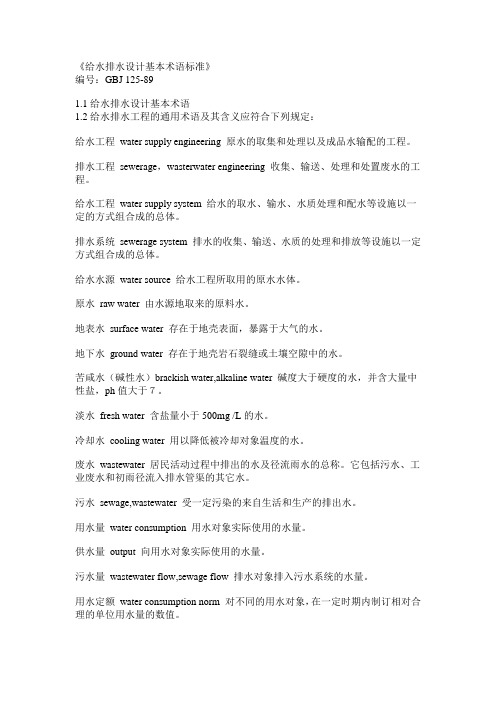
《给水排水设计基本术语标准》编号:GBJ 125-891.1给水排水设计基本术语1.2给水排水工程的通用术语及其含义应符合下列规定:给水工程water supply engineering 原水的取集和处理以及成品水输配的工程。
排水工程sewerage,wasterwater engineering 收集、输送、处理和处置废水的工程。
给水工程water supply system 给水的取水、输水、水质处理和配水等设施以一定的方式组合成的总体。
排水系统sewerage system 排水的收集、输送、水质的处理和排放等设施以一定方式组合成的总体。
给水水源water source 给水工程所取用的原水水体。
原水raw water 由水源地取来的原料水。
地表水surface water 存在于地壳表面,暴露于大气的水。
地下水ground water 存在于地壳岩石裂缝或土壤空隙中的水。
苦咸水(碱性水)brackish water,alkaline water 碱度大于硬度的水,并含大量中性盐,ph值大于7。
淡水fresh water 含盐量小于500mg /L的水。
冷却水cooling water 用以降低被冷却对象温度的水。
废水wastewater 居民活动过程中排出的水及径流雨水的总称。
它包括污水、工业废水和初雨径流入排水管渠的其它水。
污水sewage,wastewater 受一定污染的来自生活和生产的排出水。
用水量water consumption 用水对象实际使用的水量。
供水量output 向用水对象实际使用的水量。
污水量wastewater flow,sewage flow 排水对象排入污水系统的水量。
用水定额water consumption norm 对不同的用水对象,在一定时期内制订相对合理的单位用水量的数值。
排水定额wastewater flow norm 对不同的排水对象,在一定时期内制订相对合理的单位排水量的数额。
- 1、下载文档前请自行甄别文档内容的完整性,平台不提供额外的编辑、内容补充、找答案等附加服务。
- 2、"仅部分预览"的文档,不可在线预览部分如存在完整性等问题,可反馈申请退款(可完整预览的文档不适用该条件!)。
- 3、如文档侵犯您的权益,请联系客服反馈,我们会尽快为您处理(人工客服工作时间:9:00-18:30)。
For process wastewaters
•to remove toxic pollutants
-Heavy metal removal, precipitation
-oxidation / reduction for toxic organic
pollutants removal
-adsorption i.e. Activated carbon
-stripping, ion exchange
etc.
SECONDARY TREATMENT
-Biological degradation of organic compounds (aerobic / anaerobic)
-Microorganisms and solids will be allowed
to settle
-Recycle of a fraction of sludge
** toxic residues have to be removed prior to biological treatment **
TERTIARY TREATMENT
•to remove specific types of residuals
-filtration : to remove suspended or colloidal solids -adsorption, chemical oxidation : remove organics -ozonation, chlorination : disinfection
** all these processes have their place in overall Wastewater treatment scheme **
SELECTION OF A TREATMENT PROCESS Depends upon :
1.Characteristics of the wastewater
-Form of pollutants suspension
colloidal
dissolved -Biodegradability
-Toxicity of the components
2. The required effluent quality
3. The costs
4. The availibility of land
Method Activated Sludge Trickling Filter RBC
mode of operation complete mixed plug flow sludge recycle continuous application multistage continuous
degree of treatment
land requirement
earth or concrete >90 % removal 0.56 – 2.62 of organics m2/(m3/d) intermediate or high 5.52-34.4 m2/(1000m3/d)
intermediate or high intermediate
Anaerobic complete mix
Physical and chemical waste treatment
Method Ion Exchange waste plating nuclear mode degree of treatment
continuous demineralized water filtration product recovery complete removal of Cr & heavy metals complete removal of suspended and colloidal matters
Reduction plating batch Precipitation heavy metal Coagulation paper board batch refinery rubber, paint textile
Water Treatment Processes
Method
waste
mode column of activated carbon
degree of treatment complete removal of most organics
Adsorption toxic or organic refractory Chemical Oxidation toxic & refractory organics
batch or partial or continuous O3 complete oxidation or catalyzed H 2 O2
Water Treatment Processes
Ex. Municipal wastewater Water screening Sedimentation tank
disinfection
clarifier Sludge thickening Anearobic digesters
Aeration tank
Land uses
Belt presses
Water Treatment Processes
Ex. Drinking water
Raw water (source water)
Coagulation/ flocculation
sedimentation
Disinfection
filtration (Layer of charcoal, sand,Gravel)
Water Treatment Processes
Pure water treatment
Ex. Oil removal and separation
Corrugated Plate Interceptors (CPI’s)
•Efficient gravity separators •Removal of gross solids and free oil •>75% free oil removal Dissolved Air Flotation (DAF)
Ex. Wastewater from sulfite Pulp and paper Conventional treatment comprises 1. Preliminary treatment 2. Primary or physical treatment (sedimentation) 3. Secondary or biological treatment (activated sludge, aerated 1 lagoons or biofiltration) 4. Sludge treatments (sludge dewatering)
。
